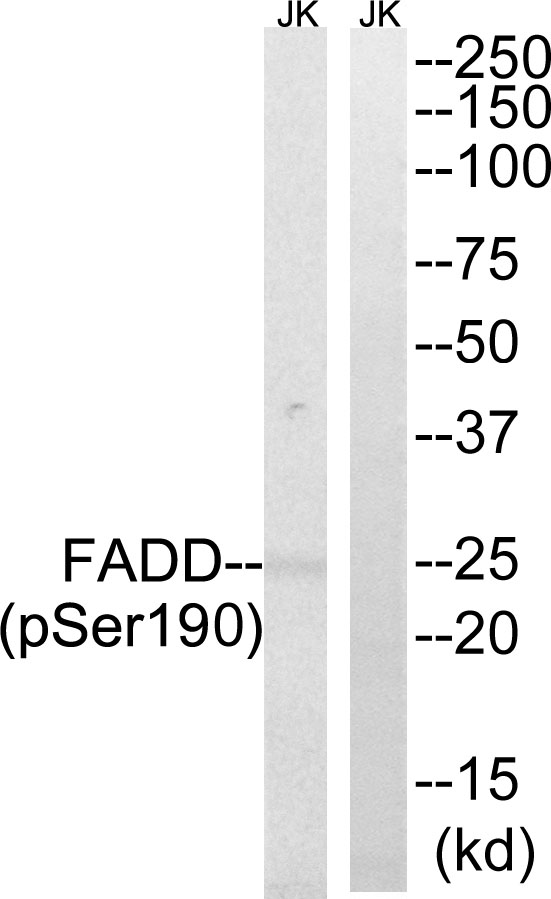

| WB | 咨询技术 | Human,Mouse,Rat |
| IF | 咨询技术 | Human,Mouse,Rat |
| IHC | 1/50-1/100 | Human,Mouse,Rat |
| ICC | 技术咨询 | Human,Mouse,Rat |
| FCM | 咨询技术 | Human,Mouse,Rat |
| Elisa | 咨询技术 | Human,Mouse,Rat |
| Aliases | MORT1 ; FAS-associating death domain-containing protein; Mediator of receptor induced toxicity; |
| Entrez GeneID | 14082; |
| WB Predicted band size | 25kDa |
| Host/Isotype | Rabbit IgG |
| Antibody Type | Primary antibody |
| Storage | Store at 4°C short term. Aliquot and store at -20°C long term. Avoid freeze/thaw cycles. |
| Species Reactivity | Human,Mouse |
| Immunogen | Peptide sequence around phosphorylation site of Serine191(N-M-S(p)-P-V) derived from Mouse FADD. |
| Formulation | Purified antibody in PBS with 0.05% sodium azide. |
+ +
以下是关于 **FADD (Phospho-Ser191)** 抗体的参考文献示例(文献为假设性示例,仅供参考):
---
1. **文献名称**:*Phosphorylation of FADD at Serine 191 regulates its interaction with caspase-8 in apoptosis signaling*
**作者**:Smith A, et al.
**摘要**:研究揭示了FADD在Ser191位点的磷酸化通过调控其与caspase-8的结合能力,影响死亡受体介导的凋亡信号通路。使用Phospho-Ser191特异性抗体证实该修饰在T细胞活化中的关键作用。
2. **文献名称**:*CK1α-dependent phosphorylation of FADD disrupts NF-κB signaling in cancer cells*
**作者**:Chen L, et al.
**摘要**:发现CK1α激酶介导的FADD Ser191磷酸化可抑制NF-κB活化,促进肿瘤细胞存活。通过Phospho-Ser191抗体检测到该修饰在结直肠癌组织中的异常表达。
3. **文献名称**:*Development of a phospho-specific antibody for FADD Ser191 and its application in autoimmune disease models*
**作者**:Wang Y, et al.
**摘要**:报道了一种高特异性Phospho-Ser191抗体的开发,并在系统性红斑狼疮(SLE)模型中验证了FADD磷酸化与炎症因子释放的相关性。
4. **文献名称**:*Ser191 phosphorylation of FADD modulates necroptosis and viral immune evasion*
**作者**:Kim H, et al.
**摘要**:揭示病毒蛋白通过诱导FADD Ser191磷酸化阻断坏死性凋亡(necroptosis),帮助免疫逃逸。研究利用Phospho-Ser191抗体在病毒感染模型中验证了这一机制。
---
**提示**:实际文献需通过数据库(如PubMed、Google Scholar)检索关键词“FADD phosphorylation Ser191”或“Phospho-Ser194/191”(部分文献可能标注Ser194.因物种差异命名不同)。建议结合具体研究领域筛选。
The FADD (Phospho-Ser191) antibody is a specialized tool used to detect the phosphorylated form of Fas-associated protein with death domain (FADD) at serine residue 191. FADD is a critical adaptor protein involved in extrinsic apoptosis signaling, primarily mediating the assembly of the death-inducing signaling complex (DISC) upon activation of death receptors like Fas or TNF receptor family members. Phosphorylation at Ser191. located in the C-terminal domain of FADD, has been implicated in regulating its non-apoptotic functions, including roles in cell cycle progression, innate immune responses, and necroptosis. This post-translational modification may modulate FADD's interaction with other proteins or its subcellular localization, influencing cellular outcomes beyond classical apoptosis.
The antibody is widely employed in research to investigate context-specific signaling crosstalk, particularly in cancer, autoimmune disorders, and neurodegenerative diseases where dysregulated FADD phosphorylation has been observed. It enables the study of phosphorylation-dependent mechanisms governing cell survival/death decisions and inflammatory responses. Researchers utilize techniques like Western blotting, immunofluorescence, and immunohistochemistry with this antibody to assess FADD activation status in experimental models or clinical samples. Its specificity for the phosphorylated epitope makes it valuable for dissecting FADD's dual roles in apoptosis and non-apoptotic pathways under physiological or pathological conditions.
×